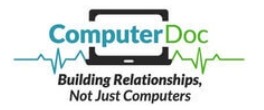Moving forward, we can expect to see a wide variety of sophisticated and complex cyberattacks, including social engineering, ransomware, DDoS attacks, third-party exposures and exploitation of cloud computing vulnerabilities. As suspected, many of these attacks and their devastating impacts can be linked back to when there were unsecured gaps that developed when companies and their employees were thrust from their secure on-premise IT infrastructures to remote networking capabilities.
The key here is that, at a time when organizations are at their most vulnerable and trying to take their first steps back to their office environment, malicious actors are continuing to ramp up their efforts. To combat an ever-evolving range of cybersecurity threats and compliance requirements, it’s time to invest in a plan of attack that combines new technology and integrations with tried-and-true best practices.
In this article, the experts at Computer Doc will cover several best security practices to protect your network today and into the future. If you’re interested in protecting your team with reliable cloud security, mobile device management, and more, contact us today.
Step 1: Determine Where Your Vulnerabilities Lie
Do you ever wish you had a way of identifying potential threats and how they could impact your organization before they occur? With a comprehensive security risk assessment, not only can you identify and mitigate potential threats, but you can pinpoint the source of the threat, understand that the threat will likely materialize, and recognize ways you can remediate vulnerabilities in your organization. Common tasks performed in a risk assessment include the following:
- Review the adequacy of your organization’s existing security policies and procedures
- Analyze threat and vulnerabilities, including likelihood and impact
- Review agreements involving products or services from vendors
- Review logical access and other methods of authentication
- Check the configuration, usage and maintenance of firewalls, servers, and remote access systems
- Create a report that documents the assets at risk, their corresponding threats, likelihood of occurrence and potential impact for future decision-making
- Develop an assessment policy that defines what your organization must do to address and mitigate the identified risks
Step 2: Adopt Proactive Cybersecurity Solutions
Once you’ve identified the current and emerging threats posed to your organization, it’s time to invest in a cybersecurity strategy that covers all of your bases, including cloud security, network security, VPNs, firewalls, data backup and mobile device protection. This typically involves gaining an in-depth understanding of the assets your organization is expected to protect. Then, you need to determine the appropriate level of risk exposure for your organization and get to know the threat landscape. Lastly, you will need to create a multi-layered strategy that addresses the vulnerabilities of your current security measures.
Step 3: Turn to Your Employees
When it comes to mitigating cybersecurity threats, your enterprise and all of its stakeholders need to be savvy. The basis for preventing a cyberattack of any kind starts with knowledge of cybersecurity best practices and the role you play in defending the organization from risks. When employers prioritize cybersecurity awareness training to address constantly evolving threats, it helps mitigate one of the most prevalent risk factors: human error. Some of the largest data breaches have occurred as a result of one employee falling prey to a phishing scheme that popped up in their inbox. Whether your method of prioritizing cybersecurity awareness involves creating a bulletin of cybersecurity news or routine sessions on secure browsing practices, it’s important to keep new and emerging cyberthreats in your line of vision at all times.
Step 4: Partner with a Dedicated Technology Partner
Last but certainly not least, you’ll want to work with a dedicated technology partner that can help ensure you accomplish all of your IT and cybersecurity business goals with ease. No matter whether you’re looking to ramp up your cloud security or double down on ransomware prevention and response, Computer Doc is here to provide you with a strategy customized specifically for the technology needs and compliance requirements of your business. No stress, no hassle, and no strings attached. Contact our team of security experts today.



